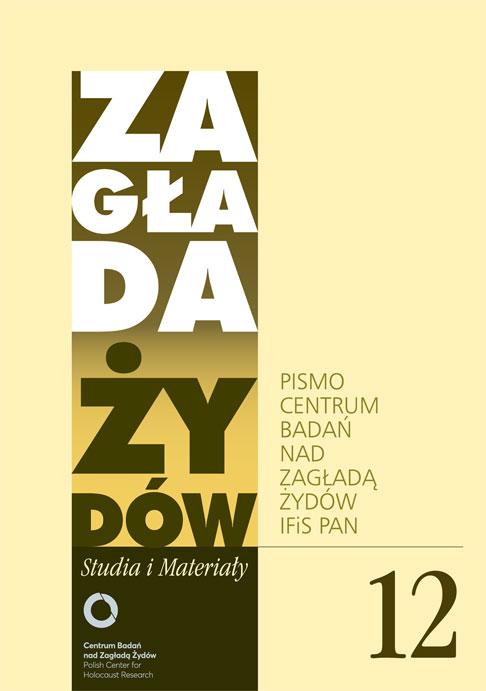Frankenstein w warszawskim getcie. Historia i legenda
Zagłada Żydów. Studia i Materiały, Nr 12 (2016), Strony: 187-208
Data zgłoszenia: 2020-10-19Data publikacji: 2016-11-30
 https://doi.org/10.32927/ZZSiM.414
https://doi.org/10.32927/ZZSiM.414
Abstrakt
The article deals with one exceptionally violent German perpetrator who was part of the occupation force in Warsaw during the Second World War. Inside the Ghetto he maltreated and killed a large number of women, children and men for his own personal pleasure. He did this to such an extensive degree that the population perceived him as monstrous being that was given the nickname „Frankenstein”. The article is mainly based on statements in juridical investigations, from the victim as well as from the perpetrator perspective, supplemented with some selected additional sources. Firstly the source corpus will be evaluated, to work out how these historical sources can be used to shed light on „Frankenstein”. This will be followed by an analysis of the actual identity of this perpetrator. It will be shown that he was, contrary to common belief, not necessarily the SS-Rottenführer Josef Blösche but more likely a member of the German Police Battalion 61. In the end the question will be also raised of how it was possible – despite all rules and regulations – that ghetto guards like him behaved like a marauding soldiery.
Słowa kluczowe
getto warszawskie , Zagłada , policja umundurowana , zbrodnie okupacyjne , warty w getcie , batalion policyjny , sprawca , przemoc , strach , terror , życie w getcie
Licencja
Prawa autorskie (c) 2016 Autor&"Zagłada Żydów. Studia i Materiały"

Utwór dostępny jest na licencji Creative Commons Uznanie autorstwa 4.0 Międzynarodowe.
https://creativecommons.org/licenses/by/4.0
Czasopismo publikowane jest w standardzie Diamond Open Access na licencji CC-BY-4.0 Deed - Uznanie autorstwa 4.0 Międzynarodowa - Creative Commons
Podobne artykuły
- Jan Grabowski, Przegląd dyskusji o kolaboracji na łamach „Slavic Review” 2005, t. 4 (64) , Zagłada Żydów. Studia i Materiały: Nr 2 (2006)
- Michał Sobelman, Unger Michael, Łódź – ostatnie getto w Polsce [tłum tytułu z hebr.] , Zagłada Żydów. Studia i Materiały: Nr 2 (2006)
- Johannes Breit, Lukas Meissel, Igraszki z symboliką Zagłady. Seria gier komputerowych „Wolfenstein” jako studium przypadku cyfrowych reprezentacji Zagłady , Zagłada Żydów. Studia i Materiały: Nr 17 (2021)
- Roman Romantsov, Od radzieckiej amnezji do ukraińskiej (nie)pamięci. Zagłada w pamięci kulturowej Ukrainy 1991–2017 , Zagłada Żydów. Studia i Materiały: Nr 14 (2018)
- Stanisław Obirek, Zadziwiające milczenie polskiego Kościoła katolickiego o Holokauście , Zagłada Żydów. Studia i Materiały: Nr 15 (2019)
- Kamil Kijek, Konieczny kierunek i ślepy zaułek w badaniach nad zagładą Żydów na terenach dawnej Drugiej Rzeczypospolitej , Zagłada Żydów. Studia i Materiały: Nr 15 (2019)
- Michał Bilewicz, Karolina Marcinkowska, Społeczna psychologia Holokaustu: od naiwnego sytuacjonizmu do zrozumienia roli ideologii , Zagłada Żydów. Studia i Materiały: Nr 20 (2024)
- Karolina Ożóg, „Życie moje zacznie się od tego dnia, kiedy pisma od was otrzymam” Korespondencja Żydów ocalałych z Zagłady na terenie ZSRR i poszukujących swoich bliskich w Polsce (1944–1945) , Zagłada Żydów. Studia i Materiały: Nr 20 (2024)
- Adrian Sandak, Tajemnica donosu na bunkier „Krysia” odkryta , Zagłada Żydów. Studia i Materiały: Nr 19 (2023)
- Anne-Christin Klotz, Spiegel Jasmin, „To nie jest czas, by śnić?” Eksploracyjna lektura psychoanalityczno-historyczna wybranych snów na podstawie pamiętników ofiar Holokaustu w okupowanej Polsce (1939–1945) , Zagłada Żydów. Studia i Materiały: Nr 20 (2024)
<< < 15 16 17 18 19 20 21 22 23 24 25 26 27 28 29 30 31 32 33 34 35 36 37 38 39 40 41 42 43 44 45 46 47 48 49 50 51 52 53 54 55 56 57 > >>
Możesz również Rozpocznij zaawansowane wyszukiwanie podobieństw dla tego artykułu.
 English
English
 Język Polski
Język Polski




